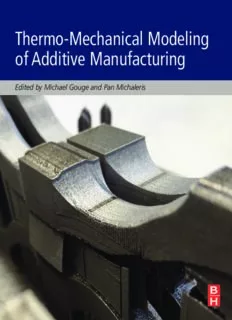Table Of ContentThermo-Mechanical Modeling
of Additive Manufacturing
Edited by Michael Gouge and Pan Michaleris
THERMO-MECHANICAL MODELING OF
ADDITIVE MANUFACTURING
This page intentionally left blank
THERMO-MECHANICAL
MODELING OF
ADDITIVE
MANUFACTURING
Editedby
Michael Gouge
Pan Michaleris
Butterworth-HeinemannisanimprintofElsevier
TheBoulevard,LangfordLane,Kidlington,OxfordOX51GB,UnitedKingdom
50HampshireStreet,5thFloor,Cambridge,MA02139,UnitedStates
Copyright©2018ElsevierInc.Allrightsreserved.
Nopartofthispublicationmaybereproducedortransmittedinanyformorbyanymeans,electronicormechanical,
includingphotocopying,recording,oranyinformationstorageandretrievalsystem,withoutpermissioninwritingfrom
thepublisher.Detailsonhowtoseekpermission,furtherinformationaboutthePublisher’spermissionspoliciesandour
arrangementswithorganizationssuchastheCopyrightClearanceCenterandtheCopyrightLicensingAgency,canbe
foundatourwebsite:www.elsevier.com/permissions.
ThisbookandtheindividualcontributionscontainedinitareprotectedundercopyrightbythePublisher(otherthanas
maybenotedherein).
Notices
Knowledgeandbestpracticeinthisfieldareconstantlychanging.Asnewresearchandexperiencebroadenour
understanding,changesinresearchmethods,professionalpractices,ormedicaltreatmentmaybecomenecessary.
Practitionersandresearchersmustalwaysrelyontheirownexperienceandknowledgeinevaluatingandusingany
information,methods,compounds,orexperimentsdescribedherein.Inusingsuchinformationormethodstheyshouldbe
mindfuloftheirownsafetyandthesafetyofothers,includingpartiesforwhomtheyhaveaprofessionalresponsibility.
Tothefullestextentofthelaw,neitherthePublishernortheauthors,contributors,oreditors,assumeanyliabilityforany
injuryand/ordamagetopersonsorpropertyasamatterofproductsliability,negligenceorotherwise,orfromanyuseor
operationofanymethods,products,instructions,orideascontainedinthematerialherein.
LibraryofCongressCataloging-in-PublicationData
AcatalogrecordforthisbookisavailablefromtheLibraryofCongress
BritishLibraryCataloguing-in-PublicationData
AcataloguerecordforthisbookisavailablefromtheBritishLibrary
ISBN:978-0-12-811820-7
ForinformationonallButterworth-Heinemannpublications
visitourwebsiteathttps://www.elsevier.com/books-and-journals
Publisher:MatthewDeans
AcquisitionEditor:ChristinaGifford
EditorialProjectManager:AnnaValutkevich
ProductionProjectManager:NickyCarter
Designer:MarkRogers
TypesetbyVTeX
Contents
List of Contributors xi 2. TheFiniteElementMethodforthe
About the Editors xiii Thermo-MechanicalModelingofAdditive
Acknowledgments xv ManufacturingProcesses
MICHAELGOUGE,PANMICHALERIS,
I ERIKDENLINGER,ANDJEFFIRWIN
THE FUNDAMENTALS OF
Introduction 19
ADDITIVE MANUFACTURING 2.1 ANon-LinearFiniteElementPrimer 19
2.2 TheDecoupledModel 20
MODELING
2.3 ModelTypes 20
2.4 TheThermalModel 21
1. AnIntroductiontoAdditive 2.4.1. ThermalEquilibrium 21
ManufacturingProcessesandTheir 2.4.2. TheHeatInputModel 21
ModelingChallenges 2.4.3. BoundaryLosses 22
2.5 TheMechanicalModel 25
MICHAELGOUGEANDPANMICHALERIS
2.5.1. SmallDeformationTheory 26
1.1 Motivation 3 2.5.2. LargeDeformationTheory 26
1.2 AdditiveManufacturingProcesses 5 2.5.3. TheQuietActivationStrategy 27
1.2.1. MultipassWelding 5 2.5.4. TheInactiveActivationStrategy 28
1.2.2. DirectedEnergyDeposition 6 2.5.5. TheHybridActivationStrategy 28
1.2.3. LaserPowderBedFusionsystems 8 2.6 TemperatureDependentMaterialProperties 28
1.3 ChallengesintheFiniteElementModelingof 2.7 FiniteElementMeshingforAdditive
AMProcesses 9 Processes 29
1.3.1. MaterialAddition 10 2.7.1. MeshConvergenceandHeuristics 29
1.3.2. HeatInput 10 2.7.2. MeshConvergenceandHeuristics 29
1.3.3. ThermalLosses 11 2.7.3. AdaptiveMeshing 30
2.8 ModelVerification 30
1.3.4. DistortionandResidualStress 11
2.8.1. AnalyticalSolutions 30
1.3.5. TemperatureDependentMaterial
Properties 12 2.8.2. ThePatchTest 32
1.3.6. MicrostructuralChanges 12 2.8.3. TheMethodofManufactured
Solutions 32
1.3.7. ReducingSimulationTime 14
2.9 ValidationandErrorAnalysis 34
1.4 Conclusions 14
2.9.1. ThermalErrorAnalysis 34
References 14
2.9.2. MechanicalErrorAnalysis 35
2.10 Conclusions 37
References 37
v
vi
CONTENTS
II 4. ConductionLossesduetoPartFixturing
DuringLaserCladding
THERMOMECHANICAL
MODELING OF DIRECT MICHAELGOUGE
ENERGY DEPOSITION
4.1 Introduction 61
PROCESSES 4.2 ModelingApproach 63
4.2.1. ConductionLosses,SurfaceContact,
3. ConvectionBoundaryLossesDuring andGapConductance 63
4.3 ExperimentalProcedures 64
LaserCladding
4.4 NumericalImplementation 66
MICHAELGOUGE 4.4.1. FESolver 66
4.4.2. TheFiniteElementMesh 67
3.1 Introduction 41
4.4.3. ConvectionModel 69
3.2 ModelingApproach 43
4.4.4. TheGapConductanceModel 69
3.3 ExperimentalProcedures 43
4.4.5. ModelingAssumptionsand
3.4 NumericImplementation 45
Approximations 72
3.4.1. TemporalDiscretization 45
4.5 ResultsandDiscussion 72
3.4.2. FiniteElementMesh 45
4.5.1. CantileveredFixture 72
3.4.3. TheEvolvingFreeSurface 46
4.5.2. BenchClampedFixture 74
3.4.4. NoConvection 47
4.5.3. ThermalLossModes 76
3.4.5. NaturalConvection 47
4.6 Conclusions 77
3.4.6. ForcedConvectionFromLumped
References 78
CapacitanceExperiments 48
3.4.7. ForcedConvectionBasedonPublished
5. MicrostructureandMechanical
Research 48
PropertiesofAMBuilds
3.4.8. Hot-FilmAnemometry 48
3.4.9. HeightenedNaturalConvection 52 ALLISONM.BEESE
3.5 AnalysisCases 52
3.5.1. Case1:NoConvection 52 5.1 Introduction 81
5.2 ExperimentalCharacterization 82
3.5.2. Case2:NaturalConvectionAlone 52
5.2.1. Microstructure 82
3.5.3. Case3:ForcedConvectionFrom
LumpedCapacitanceExperiments 52 5.2.2. Hardness 82
3.5.4. Case4:ForcedConvectionFromHeat 5.2.3. YieldandUltimateTensileStrengths,
TransferLiterature 52 Elongation 82
3.5.5. Case5:ForcedConvectionMeasuredby 5.2.4. Fatigue 82
Hot-FilmAnemometry 53 5.3 ExperimentalResults 83
3.5.6. Case6:ForcedConvectionWitha 5.3.1. Microstructure 83
Non-EvolvingSurface 53 5.3.2. Hardness 84
3.5.7. Case7:HeightenedNatural 5.3.3. YieldStrength,UltimateTensile
Convection 53 Strength,andElongation 86
3.6 ResultsandDiscussion 54 5.3.4. Fatigue 88
3.6.1. TheEffectofConvectionBoundary 5.4 Discussion 89
Conditions 54 5.5 Conclusions 89
3.7 Conclusions 57 References 89
References 58
vii
CONTENTS
6. UnderstandingMicrostructureEvolution 8.2 DEDSimulation 138
DuringAdditiveManufacturingofMetallic 8.3 DEDProcessMeasurementSetupandTest
AlloysUsingPhase-FieldModeling Cases 139
8.3.1. DepositionCases 139
YANZHOUJI,LEICHEN,ANDLONG-QINGCHEN
8.3.2. MeasurementSetup 140
8.4 ResultsfromtheIn-SituMeasurements 141
6.1 MicrostructuresinAdditivelyManufactured
8.5 NumericalImplementation 143
MetallicAlloys 93
8.5.1. FiniteElementMesh 144
6.1.1. ExperimentalObservations 94
8.5.2. DeterminationoftheHeatSourceand
6.1.2. ComputationalSimulations 97
SurfaceLossVariables 144
6.2 Multi-ScalePhase-FieldModelforAMof
8.6 Thermo-MechanicalModelingResults 147
Alloys 99
8.7 Conclusions 149
6.2.1. LinkageBetweentheThree
References 150
Sub-Models 100
6.2.2. Finite-ElementThermalModel 100
9. ResidualStressandDistortionModeling
6.2.3. Grain-ScalePhase-FieldModel:Grain
ofElectronBeamDirectManufacturing
Growth&Solidification 102
Ti-6Al-4V
6.2.4. Sub-Grain-ScalePhase-FieldModel:
Solid-StatePhaseTransformations 106
ERIKR.DENLINGER
6.3 SummaryandOutlook 112
Acknowledgements 113 9.1 Introduction 153
References 113 9.2 ElectronBeamDepositionSimulation 154
9.2.1. MechanicalAnalysis 155
7. ModelingMicrostructureofAM 9.3 CalibrationandValidation 156
ProcessesUsingtheFEMethod 9.3.1. DepositionProcess 156
9.3.2. InSituDistortionandTemperature 157
JEFFIRWIN
9.3.3. ResidualStress 157
9.4 NumericalImplementation 159
7.1 Introduction 117
9.5 ResultsandDiscussion 160
7.2 MicrostructuralModel 119
9.5.1. ThermalHistory 160
7.2.1. PhaseFractionsandMorphology 119
9.5.2. DistortionHistory 162
7.2.2. αLathWidth 122
9.5.3. ResidualStress 163
7.2.3. SummaryofModel 123
9.6 Conclusions 164
7.2.4. ModelOptimization 124
References 165
7.3 ExperimentalImplementation 124
7.3.1. DepositionProcess 124
10. Thermo-MechanicalModelingofLarge
7.3.2. MeasurementofαLathWidth 125
ElectronBeamBuilds
7.4 ResultsandDiscussion 126
7.5 Conclusions 132
ERIKR.DENLINGER
References 133
10.1 Introduction 167
8. Thermo-MechanicalModelingofThin 10.2 ElectronBeamDepositionSimulation 169
WallBuildsusingPowderFedDirected 10.3 MeshCoarseningAlgorithm 169
10.3.1. MergingofElementsLayerby
EnergyDeposition
Layer 169
JARREDC.HEIGEL 10.3.2. InterpolationofGaussPoint
Values 169
8.1 Introduction 137
viii
CONTENTS
10.3.3. VerificationofLayerbyLayer 12.3.1. DynamicAdaptiveMesh
CoarseningAlgorithm 171 Implementation 201
10.3.4. VerificationResults 172 12.3.2. StaticNonconformingMesh
10.4 ValidationonaLargePart 173 Analysis 204
10.5 NumericalImplementation 175 12.3.3. StaticConformingMeshAnalysis 204
10.6 ResultsandDiscussion 177 12.4 Verification 206
10.7 Conclusions 178 12.4.1. NumericalImplementation 206
References 179 12.4.2. AssessmentofAccuracy 206
12.5 ResultsandDiscussion 209
11. MitigationofDistortioninLarge 12.5.1. EffectofCoarseningTemperatureon
AdditiveManufacturingParts DynamicMeshingAccuracy 209
12.6 Conclusions 211
ERIKR.DENLINGER
References 211
11.1 Introduction 183
13. ThermomechanicalModel
11.2 EvaluationofDistortionMitigation
Techniques 185 DevelopmentandIn-SituExperimental
11.2.1. ElectronBeamDeposition ValidationoftheLaserPowder-BedFusion
Simulation 185 Process
11.2.2. NumericalModel 185
ERIKR.DENLINGER
11.2.3. DepositionStrategies 186
11.2.4. SmallModelResults 188
13.1 Introduction 215
11.3 MitigationTechniquesAppliedonaLarge
13.2 ModelingApproach 217
Part 190
13.3 ExperimentalValidation 217
11.3.1. ExperimentalProcedure 190
13.3.1. ProcessingParameters 217
11.3.2. DepositionCases 191
13.3.2. DistortionandTemperature
11.4 ResultsandDiscussion 192
Measurements 218
11.5 Conclusions 194
13.4 NumericalImplementation 218
References 194
13.4.1. SolutionMethod 218
13.4.2. TheFiniteElementMesh 220
III
13.4.3. BoundaryConditions 221
THERMOMECHANICAL 13.4.4. MaterialDepositionModeling 221
13.5 ResultsandDiscussion 221
MODELING OF POWDER BED
13.5.1. ThermalResults 221
PROCESSES
13.5.2. MechanicalResults 221
13.6 Conclusions 225
12. DevelopmentandNumerical References 225
VerificationofaDynamicAdaptiveMesh
CoarseningStrategyforSimulatingLaser 14. StudyoftheEvolutionofDistortion
PowerBedFusionProcesses DuringthePowderBedFusionBuild
ProcessUsingaCombinedExperimental
ERIKR.DENLINGER
andModelingApproach
12.1 Introduction 199 ALEXANDERJ.DUNBAR
12.2 ModelingApproach 201
12.3 MeshingStrategies 201 14.1 Introduction 229
14.2 Experiment 231
ix
CONTENTS
14.2.1. ExperimentalSetup 231 15.4 NumericalImplementation 256
14.2.2. ExperimentalResults 234 15.4.1. AutomaticMeshGenerationFroma
14.3 PowderBedFusionSimulation 237 SourceCADFile 256
14.3.1. NumericalImplementation 237 15.4.2. DwellTimeMultiplier 257
14.4 ResultsandDiscussion 239 15.4.3. ValidationCriteria 257
14.4.1. ModelComparisontoExperimental 15.5 ResultsandDiscussion 258
Measurements 239 15.5.1. MeshConvergenceStudyResults 258
14.4.2. SubstrateDeformation 241 15.5.2. ValidationStudy 258
14.4.3. ExtensionofRotatingScanPattern 15.6 Conclusions 261
Case 243 References 261
14.4.4. DistortionEvolutioninTime 244
14.5 Conclusion 248
A. Appendix
References 249
A.1 MaterialPropertiesUsedinFEModeling 265
15. ValidationoftheAmericanMakes A.1.1. Aluminum6061Properties 265
Builds A.1.2. Inconel®625Properties 265
A.1.3. Inconel®718Properties 267
JEFFIRWINANDMICHAELGOUGE
A.1.4. SAE304 268
15.1 Introduction 251 A.1.5. Ti-6Al-4V 268
15.2 ModelingApproach 254 References 269
15.3 ExperimentalProcedures 255
15.3.1. ExperimentalValidationGeometry 255 Index 271
15.3.2. Post-ProcessMeasurementof
Distortion 255
Description:Thermo-mechanical Modeling of Additive Manufacturingprovides the background, methodology and description of modeling techniques to enable the reader to perform their own accurate and reliable simulations of any additive process. Part I provides an in depth introduction to the fundamentals of additiv

